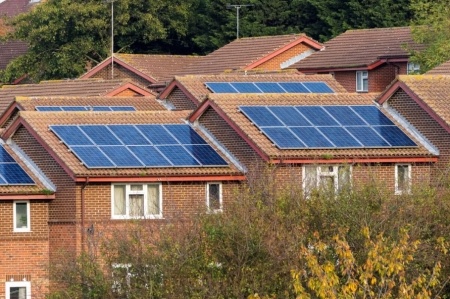
What steps can I take to make my home zero carbon?
If we want to help Britain achieve Net Zero, we've got to break free from our reliance on gas for heating. Did you know that almost 30% of the UK's total greenhouse emissions come from heating our homes? It's time to explore alternative options and find greener ways to keep our homes cosy.
Nevertheless, moving towards a greener home can feel out of reach, at least for those who aren’t buying a new, modern home or don’t have an ambitious architect on speed dial. However, cutting the carbon associated with your home doesn’t have to mean moving out for months while a team of builders move in. It doesn’t have to be prohibitively expensive, either. It’s a journey that you can take in stages, and it puts you in more control of the energy your home consumes every step of the way.
Step 1: Understand your energy consumption
Step 2: Insulate your home to keep heat in
Step 3: Get away from gas with an air source heat pump
Step 4: Generate your own electricity with solar panels and battery storage
Step 5: Build a zero carbon lifestyle around your zero carbon home
Step 1: Understand your energy consumption
Installing a smart meter is the essential first step in lowering your home's carbon footprint. Your smart meter’s handy in-home display will show you how you use energy and help you make small changes to become more efficient. Moreover, your smart meter will send readings automatically so that you get more accurate bills(1) and feel the immediate benefit of reducing your energy use. There's no cost to install a smart meter, and with today’s smart meter technology, you won’t need broadband or wi-fi internet for it to work.
We're aiming to give all EDF customers a smart meter. Once yours is up and running, you’ll be able to get personalised tips for saving energy through our Energy Hub. With Energy Hub you can save around £41(2)and cut your carbon footprint.
In addition to installing a smart meter, you can get an Energy Performance Certificate (EPC) to understand what your home needs to become more energy efficient. Once you have your EPC, it not only gives you a clear picture of your home's current energy performance but also provides suggestions on how to improve it. By following these recommendations, you can reduce your energy consumption and save money on your energy bills.
Step 2: Insulate your home to keep heat in
Energy efficiency is the key to moving closer towards a zero-carbon home, ensuring that the heat you generate and pay for isn't wasted. Improving your home's energy efficiency helps keep it at a stable, comfortable temperature by preventing heat from escaping.. A typical home without insulation will lose 33% of heat through the walls and 25% through the roof – and most homes in the UK are losing heat in this way. Research in April 2022(3) found that only a third of UK homes have ever updated their insulation.
EDF uses a network of professional installation companies which can fit insulation to suit the type of home that you have. Properties built since the 1920s will likely have cavity walls that your installer can inject insulation into. If your property is older, with solid walls, you can choose between external or internal insulation.
Most properties benefit from loft insulation, which creates a thermal barrier in the roof to prevent heat loss.
Insulating your loft and your walls can cut up to £870(4) from your energy bills each year. Properly insulating your home also means installing low-carbon technology will work more effectively, and you'll be eligible for the Boiler Upgrade Scheme.
You can also find out if you're eligible for the Great British Insulation Scheme, helping households with the cost of insulating their homes.
Step 3: Get away from gas with an air source heat pump
Installing a heat pump means you can move away from gas boilers and put an end to heating your home using fossil fuels.
An air source heat pump works like a reverse fridge. It extracts hidden heat from the air outside your home and moves it into your home, using electricity to do so. Because they run on a combination of electricity and thin air, heat pumps can be entirely powered by zero carbon energy. EDF is the UK’s largest supplier of zero carbon energy, and so we’re able to help more homes cut the carbon emissions from heating with our tariffs. Learn more about the science behind a heat pump using our heat pump guide.
EDF has invested in the expert heat pump installing company, CB Heating, who provide all our heat pumps. Once they've installed your bespoke heat pump system, you'll get comfortable and consistent heat and hot water. According to Energy Saving Trust, you'll also get reduced running costs and much greater reliability.
If an air source heat pump isn't suitable for your home and needs, you may want to look at other low-carbon electric heating options, such as electric radiators and storage heaters. With a fully electric home, you pay one standing charge and get one easy-to-understand bill.
Step 4: Generate your own electricity with solar panels and battery storage
If you’ve installed an air source heat pump, you’ll now be heating your home through electricity rather than gas or oil. Why not create some of the electricity required to run the heat pump with your own solar energy?
Solar technology is cheaper and more efficient than ever before! Installing solar panels means that you have to worry a lot less about rising energy prices, and you could be saving up to £525(5) a year. Adding a battery to your solar panel system means you can store your energy and use it at night when the sun isn’t shining; no wonder they're more popular than ever. With EDF’s Smart Export Guarantee tariff, you can sell any unused energy back to the grid at a guaranteed rate.
Step 5: Build a zero-carbon lifestyle around your zero-carbon home
Congratulations! With efficient, electric heating powered by your own solar panels, you’ve created a zero-carbon home that’s cosy and comfortable, protects you from energy price rises and is helping Britain on the road to net zero. Your zero-carbon journey doesn’t have to end here, though. Switching to an electric vehicle (EV) is another big step towards cutting your overall carbon footprint.
EDF provides everything that you need to get on the road to zero-carbon driving. You can lease an EV from top brands like Tesla, Volkswagen, Audi and MG through our partner DriveElectric. You can save money, and you can use guaranteed zero-carbon electricity with one of our GoElectric EV tariffs. With Pod Point, which is now part of the EDF family, you can choose from a range of home EV chargers so you can find the model that’s right for you
Related articles

Are solar panels worth it?

Should I fix my energy tariff?
